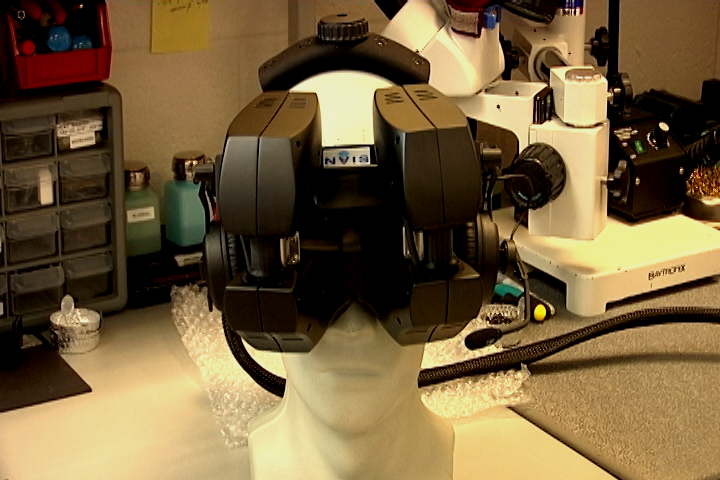RESTON, Va. — It takes a full day for an employee at NVIS to painstakingly piece together a virtual reality headset like the NVisor ST50. Sometimes even longer.

The NVisor ST50 must be put together by hand before it is shipped off to a customer. Photo: Tatiana Kouskoulas/MNS
The result is a black, oblong device more than a foot long screwed onto the helmet of a soldier, with binocular-like glasses extending in front, to transport him into another world.
Virtual reality headsets are the key to many military virtual training programs, giving gunners, tankers and helicopter crews the chance to practice key skill sets without damaging expensive equipment or train for intense combat situations they wouldn’t otherwise see unless in the field.
Headsets hook up to a computer simulator program, effectively immersing the wearer in a foreign environment where they can walk, shoot and explore. Different versions of these programs are used by the Army, the Navy, the Marines and the Air Force. Many of these fully immersive programs have one thing in common – the headset.
The Avian Combined Arms Tactical Trainer, for example, uses 276 head-mounted displays from Rockwell Collins. The Army Program Executive Office for Simulation Training and Instrumentation will launch a new dismounted soldier training program using displays from Intelligent Decisions.
“Our core market is military training and simulation,” said Marc Foglia, president of NVIS Inc., “so you will have examples of soldiers using the equipment to operate vehicles.”
The average cost for headsets, according to Foglia, is $20,000 to $40,000. The NVisor ST50 was fully funded by the Army. The research and development cost $800,000 and each headset costs $17,000. Sensics’ most expensive headset runs at $99,000.
Despite the high cost of each piece, both Jason Kaplan, vice president of business development for Sensics Panoramic head-mounted displays, and Foglia said that they do not expect a tight national security budget to hurt their businesses.
“I think there will be pressure everywhere, on every expense to justify and make sure it’s a wise spend,” Kaplan said. “But I think it’s possible that you could see an even larger move to simulation in training because it is lower cost and has a lot of the same positive impact.”
Foglia said that 2009, following the recession, was the company’s best revenue year. The company has continued to add clients and products in 2010 and 2011, even as President Barack Obama’s proposed budget for the Army would cut research funding for next-generation training and simulation systems to $18 million from 2010’s nearly $26 million; it would cut funding for research on manpower training technology by almost 15 percent.
Still, Dennis Thompson, director of the Marine Air-Ground Task Force Training Simulations Division, said the benefits of virtual training aren’t all economic.
“There’s a fallacy that virtual training is cheaper than live training. Well, maybe in the long hold but this is one of those things you got to spend money to save money,” said Thompson. “What you do save in a simulation is you can run different scenarios is a shorter time and can give the people more repetitions.”
Creating the perfect headset, like many things, is an exercise in tradeoffs, said Kaplan.
“Ideally you would want a display that you could put on your head that was lightweight like sunglasses, that had a wide field of view so you could see your entire field of vision, that had the same resolution as your eye, and wouldn’t life be great,” Kaplan said.
“We have to make decisions about what’s most important and what to give up.”
As employees make Sensics and NVIS headsets by hand, one thing they cannot give up is optical precision – making sure that each eye sees an identical picture in the same space.
The optics have to be aligned by fractions of a degree in order to keep the wearer from getting a bad case of eye strain, headaches or even fatigue and nausea according to optometry experts.
“If the two displays are not aligned properly then the convergence of your eyes that you may have to make … may not be consistent with reality,” said Austin Roorda of the University of California Berkeley.
The hand-made nature of the machines, the intricacy of the designs and the months of research and development that go into each new model contribute to the cost of the equipment.
“[The time it takes to put together a headset] can be all over the map because the optics are so complex,” said Jonathan Lee, the NVIS production manager who puts the sets together. “Funny little anomalies show up and then you have to go in and readjust.”
